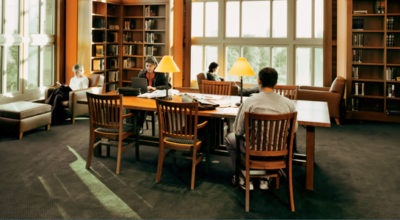Emmett Institute Faculty Publications Selected Among Top Five Articles in Environmental Law in 2018

Editors of the definitive annual compilation of the most significant scholarly articles in environmental law have selected articles by Emmett Institute faculty members Ann Carlson and Jim Salzman for their 2018 edition. The Land Use and Environmental Law Review selects the top five articles each year through a peer review process.
Ann Carlson’s article in UCLA Law Review addresses the Clean Air Act’s shortcomings in microclimates with high levels of local air pollution. Jim Salzman’s article (with J.B. Ruhl and Jonathan Remy Nash) in Minnesota Law Review considers the relationship between federal agency budgets and environmental quality. Both articles will be published in the latest edition of Land Use and Environmental Law Review, an annual Thomson Reuters/West publication edited by Ruhl and David Callies.
The editors identified more than 300 articles published in 2018 on environmental law issues. Dozens of peer faculty then conducted two rounds of review to arrive at the top five articles to be re-printed.
In addition to selecting articles by Professors Carlson and Salzman for reprinting, the editors also selected, as a finalist candidate, an article published by Nicholas Bryner in Idaho Law Review during his time as an Emmett/Frankel Fellow in Environmental Law and Policy at the Emmett Institute. Bryner’s article suggests environmental interests and values justify a substantive canon of construction, a set of ground rules judges rely on in interpreting statutes. Bryner is now assistant professor of law at LSU Law.
The full list of articles, in alphabetical order, is below:
Articles selected for reprinting in 2018 Land Use and Environmental Law Review:
- Ann E. Carlson. The Clean Air Act’s blind spot: microclimates and hotspot pollution. 65 UCLA L. Rev. 1036-1088 (2018).
- Alyson C. Flournoy. Beach law cleanup: how sea-level rise has eroded the ambulatory boundaries legal framework. 42 Vt. L. Rev. 89-152 (2017).
- Sanne H. Knudsen. Regulating cumulative risk. 101 Minn. L. Rev. 2313-2396 (2017).
- Zachary Liscow and Quentin Karpilow. Innovation snowballing and climate law. 95 Wash. U. L. Rev. 387-464 (2017).
- Jonathan Remy Nash, J.B. Ruhl, and James Salzman. The production function of the regulatory state: how much do agency budgets matter? 102 Minn. L. Rev. 695-759 (2017).
Other finalists:
- Nicholas S. Bryner. An ecological theory of statutory interpretation. 54 Idaho L. Rev. 3-44 (2018).
- Jamison E. Colburn. Technology-based? Cost factoring in U.S. environmental standards. 7 Mich. J. Envtl. & Admin. L. 83-129 (2017).
- Robert L. Fischman and Lydia Barbash-Riley. Empirical environmental scholarship. 44 Ecology L.Q. 767-807 (2018).
- Lisa Heinzerling. Unreasonable delays: the legal problems (so far) of Trump’s deregulatory binge. 12 Harv. L. & Pol’y Rev. 13-48 (2018).
- David Takacs. Are koalas fungible? Biodiversity offsetting and the law. 26 N.Y.U. Envtl. L.J. 161-226 (2018).
- Justin R. Pidot, Dale Ratliff. The common law of liable party CERCLA claims. 70 Stan. L. Rev. 191-263 (2018).
- Richard L. Revesz and Burcin Unel. Managing the future of the electricity grid: energy storage and greenhouse gas emissions. 42 Harv. Envtl. L. Rev. 139-196 (2018).
- Kalyani Robbins. Allocating property interests in ecosystem services: from chaos to flowing rivers. 42 Harv. Envtl. L. Rev. 197-229 (2018).
- Cass R. Sunstein. Changing climate change, 2009-2016. 42 Harv. Envtl. L. Rev. 231-285 (2018).
- Michael P. Vandenbergh, David J. Vandenbergh, and John G. Vandenbergh. Lamarck revisited: the implications of epigenetics for environmental law. 7 Mich. J. Envtl. & Admin. L. 1-49 (2017).







Reader Comments